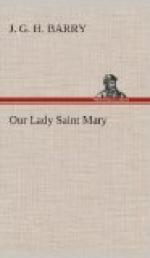We shall not, then, find it any bar to the acceptance of belief in the assumption of our Lady that its formal statement came, as is said, “late.” We simply want to know that when it came it came as the outcome of the mature thought of the Church, the Body of Christ, the Fulness of Him that filleth all in all.
It is to be noted that the assumption is not a wholly isolated fact. There are several cases of assumption in the Old Testament though of a slightly different character in that they were assumptions directly from life without any interval of death. Such were the assumptions of Enoch and Elijah. Moses, too, it has been constantly believed, was assumed into heaven,—in his case after death and with his resurrection body. A case which is more strangely like what is believed to have taken place in the experience of blessed Mary is that closely connected with our Lord’s resurrection and recorded by S. Matthew. “And the graves were opened, and many bodies of the saints which slept arose, and came out of the graves after his resurrection, and went into the holy city, and appeared unto many.” Although it is not asserted that these were assumed into heaven, it seems impossible to avoid the inference; and if “many saints which slept” were raised from the dead and assumed into the heavenly world, there can be no a priori difficulty in believing the same thing to have taken place in the Blessed Mother of God. Nay if such a thing as an assumption is at all possible for any human being one would naturally conclude from the very relation of S. Mary to our Lord that the possibility would be realised in her.
And there were elements in her case which were lacking in all the other cases which suggest a certain fitness, if not inevitability, in her assumption. She was conceived without sin,—never had any breath of sin tainted her. Was it then possible that she should be holden by death? Surely, in any case, it was impossible that her holy body should see corruption: we cannot think of the dissolution of that body which had no part in sin. If ever an assumption were possible, here it was inevitable—so the thought of the Church shaped itself. The compelling motives of the belief were theological rather than historical. The germ out of consideration of which was evolved the belief in the assumption was the relation of Blessed Mary to her Son. That unique relation might be expected to carry with it unique consequences, and among these the consequence that the body which was bound by no sin should be reunited to the soul which had needed no purgation, but had passed at once to the presence of its God and its Redeemer who was likewise Son. It is well to stress the fact that the assumption is not only a fact but a doctrine. Fact, of course, it was or there could be no doctrine; but the truth of the fact is certified by the growing conviction in the mind of the Church of the inevitability of the doctrine.




